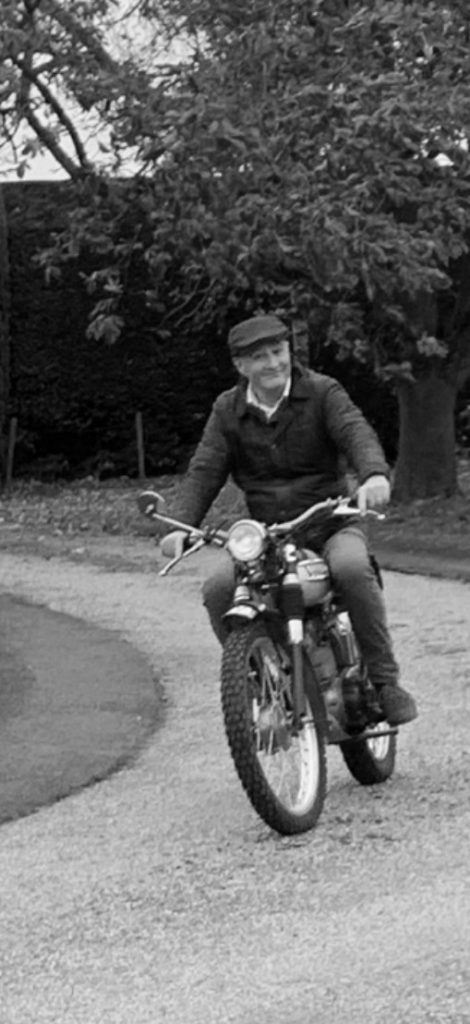Prewar Douglas Motorcycles – History and Models.
Much has already been documented on the early years of Douglas motorcycles, so I will keep this brief.
The inspiration…
Prior to 1905 and while working at a company called Parnell Scale, John (or Joseph) Barter created a 200cc horizontally-opposed twin cylinder engine. It was much like the later clipon motors as it was attached to something resembling a bicycle frame. This motorcycle was put into production and the Douglas Brothers foundry in Bristol were tasked with the job of casting the crank cases.
1907. The beginning of Douglas motorcycles.
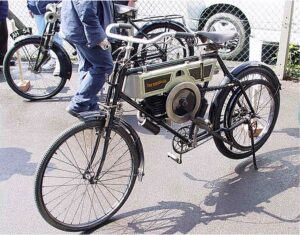 It seems that the original makers of this motorcycle sold out to a company that moved production to London. While that company continued until 1909, early Douglas motorcycles appeared in 1907 with a horizontally opposed 350cc side valve 2-3/4hp engine, looking much like the original Barter-designed machine. This was no coincidence, as Douglas hired Barter when his company went into liquidation in 1907.
It seems that the original makers of this motorcycle sold out to a company that moved production to London. While that company continued until 1909, early Douglas motorcycles appeared in 1907 with a horizontally opposed 350cc side valve 2-3/4hp engine, looking much like the original Barter-designed machine. This was no coincidence, as Douglas hired Barter when his company went into liquidation in 1907.
The sturdy little 2-3/4 Douglas was in production in the form of many updated models from 1907 to 1926. It took a few years before Barter and Douglas had developed the 2-3/4 from a bicycle with an engine, into something that resembles a motorcycle.
The first 2-speed gearbox
1910 was a significant year for Douglas motorcycles, as Barter had designed a 2-speed gearbox. This created vast sales opportunities as the competition was still struggling with single speed motorcycles. I believe Royal Enfield had also produced a 2-speed gearbox around the same time. Douglas gearboxes seem to have started with the number 101 in 1911. Not all models had the 2-speed gearbox. It wasn’t until 1915 when Douglas fitted all of this motorcycles with gearboxes.
1914 to 1923 saw production of the 3-1/2 and 4 HP side valve twins. This was due to demand for larger motorcycles that would be capable of lugging a sidecar. Early machines were use by the War Department but there were some made for civilian use.
The prewar Douglas motorcycles were basic, but effective. They were good enough to use in WW1 as a reliable mode of transport and carried the company through to 1919.
Not much happened between 1915 and 1919, with regard to development. Like many motorcycle manufacturers, Douglas managed to get a War Department contract to supply WD-Douglas 2-3.4 machines. These machines were adapted to suit the muddy use on the front lines.
Gearboxes began to have letter codes in 1919. It wasn’t unit 1925 when Douglas finally gave the frame number a letter-prefix.
1920’s. A busy decade for Douglas motorcycles
The 1920’s galvanised Douglas into production of several new models. Dirt track racing was becoming very popular, so Douglas created the DT model. It proved to be extremely popular. They also produced a Speedway (SW 500) model. The I.o.M TT was equally popular and many manufacturers had been keen to have their models race on the Island. Douglas joined the party with the works 350cc OHV model (1926 to 1929). So that the buying public could emulate their heroes, they could buy the Douglas I.o.M TT Replica model. It came with 500 / 600cc and some were supplied with extra-wide ratios.
1930’s slowdown for prewar Douglas motorcycles
The 1920’s were good for Douglas. They had produced many models and all seemed popular. The 1930’s were much more difficult years. Many motorcycle manufacturers embraced the many changes in design, including moving from flat tank models to saddle tanks. However, Douglas struggled with marketable designs and their saddle tank motorcycles were comparatively expensive to produce. Some of the models had extremely short production runs.
By 1938 Douglas only had two models in production. The Model Aero 500/600 cc SV and at the other end of the scale, a 150 cc 2-Stroke Model CL/38. These are more usually known as prewar Douglas motorcycles.
The good news is that Douglas survived the difficult 1930’s prewar years and continued with motorcycle production.
Prewar Douglas Motorcycles
** For further details on each model, see the table of engine and frame numbers**
Dating your Douglas 2-3/4 H.P. model by engine or frame number. View the table here
Dating your Douglas 3-1/2 HP or 4 HP by engine or frame number. View the table here
1907
 Model 2-3/4 H.P.- in it’s most basic form.
Model 2-3/4 H.P.- in it’s most basic form.
1908
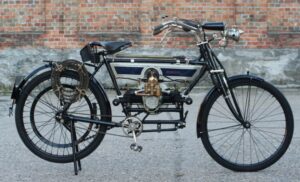 2-3/4 H.P. Model “A” as 1907 with minor updates. The ignition is now by magneto with an exposed drive gear. There is recess in the petrol tank to clear the magneto. Apparently up to 50 machines made. This may not have been designated as a Model “A”. Adverts at the time don’t mention the “A”. It may have been described this way when the Model B came into production in 1909. (This machine was sold by Motomaniastore.com)
2-3/4 H.P. Model “A” as 1907 with minor updates. The ignition is now by magneto with an exposed drive gear. There is recess in the petrol tank to clear the magneto. Apparently up to 50 machines made. This may not have been designated as a Model “A”. Adverts at the time don’t mention the “A”. It may have been described this way when the Model B came into production in 1909. (This machine was sold by Motomaniastore.com)
1909
 2-3/4 H.P. Model B as 1908 with further updates. Douglas still offered the 1908 Model “A” model. 1909 was the first year when Douglas used the silver & blue fuel tank motif. For 1909, they lowered the engine by four inches. The saddle & overall semi-diamond frame height was lowered by two inches. Further development included bracing to the headstock and an increase in the wheelbase. Druid forks were fitted and the motorcycle was supplied with a rear stand. (This machine was sold by Motomaniastore.com)
2-3/4 H.P. Model B as 1908 with further updates. Douglas still offered the 1908 Model “A” model. 1909 was the first year when Douglas used the silver & blue fuel tank motif. For 1909, they lowered the engine by four inches. The saddle & overall semi-diamond frame height was lowered by two inches. Further development included bracing to the headstock and an increase in the wheelbase. Druid forks were fitted and the motorcycle was supplied with a rear stand. (This machine was sold by Motomaniastore.com)
1910
2-3/4 H.P. Model C with the option of the new 2-speed gearbox. Douglas still offered the 1909 Model B while offering the 1910 Model C with a raft of upgrades. Model C upgrades included a cradle frame with further bracing to the headstock and two horizontal tubes below the engine. The frame was adjusted further by having the lower rear fork join the saddle post at the very bottom. This now made it in line with housing for pedalling gear. The petrol tank was not as deep and the tank sides were faceted at the front and rear. The Model C now had motorcycle-style sprung front girder forks. The engine wasn’t left out in the update. It now had cylinders mounted to the crank case with two studs. The engine pulley became adjustable and a light cover was fitted over the external magneto drive gear. Finally, the drive belt rim was perforated in a bid to save weight.
1911
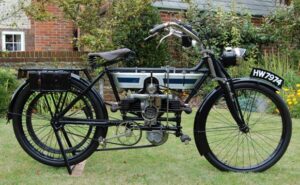 2-3/4 H.P. Models D, E, F. – Model D was really still a Model C with direct belt drive but with provision for a 2-speed gearbox which would be mounted below the engine. It was an optional extra and either fitted at Factory or at Dealership. Customers who had 1909 and 1910 frames could have them altered at factory to accommodate the new 2-speed gearbox. The 1911 Model D had a wider petrol tank which curved inward at front and rear. It also had the lower rear fork join the seat post midway between the two lower frames. It housed the pedal gear below the lower tube.
2-3/4 H.P. Models D, E, F. – Model D was really still a Model C with direct belt drive but with provision for a 2-speed gearbox which would be mounted below the engine. It was an optional extra and either fitted at Factory or at Dealership. Customers who had 1909 and 1910 frames could have them altered at factory to accommodate the new 2-speed gearbox. The 1911 Model D had a wider petrol tank which curved inward at front and rear. It also had the lower rear fork join the seat post midway between the two lower frames. It housed the pedal gear below the lower tube.
Model E was a new frame with a single frame tube below the engine. The engine was lowered (again) and it no longer had the notch in the petrol tank to clear the magneto. The lower rear fork horizontal joins the seat post slightly above the engine rail. The Model E is fitted with a chain to a 2-speed countershaft under the rear cylinder.It had a belt to the rear wheel but no pedalling gear. It now had a clutch with a hand starting option. Footboards were fitted. Model F, 2-speed gears with a clutch, hand start, open frame ladies model.
1912
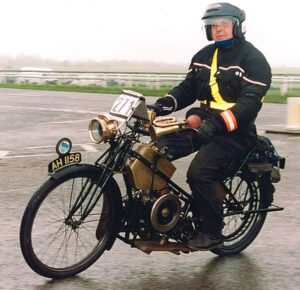 2-3/4 H.P. Models G, H, J, K. L. – Model G offered a single speed countershaft with pedalling gear and chain. It also had foot pegs. Countershaft unit moves rearward to base of saddle post, engine has mechanically operated inlet, fully encased internal magneto drive. Model J also had foot pegs but had the 2-speed gearbox and the option of drop handlebars. Model K had the 2-speed gearbox with a clutch and kick start. Model L had the same specification as K but this was the Ladies Model with an open frame. All 2-3/4 with lower frame, single frame tube below engine which lines up with lower rear fork. Addition of a diagonal tube brace between saddle post and lower rear fork. Petrol tank and top frame tube slopes down at rear to accommodate lower saddle position.
2-3/4 H.P. Models G, H, J, K. L. – Model G offered a single speed countershaft with pedalling gear and chain. It also had foot pegs. Countershaft unit moves rearward to base of saddle post, engine has mechanically operated inlet, fully encased internal magneto drive. Model J also had foot pegs but had the 2-speed gearbox and the option of drop handlebars. Model K had the 2-speed gearbox with a clutch and kick start. Model L had the same specification as K but this was the Ladies Model with an open frame. All 2-3/4 with lower frame, single frame tube below engine which lines up with lower rear fork. Addition of a diagonal tube brace between saddle post and lower rear fork. Petrol tank and top frame tube slopes down at rear to accommodate lower saddle position.
1913
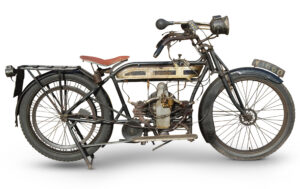 2-3/4 H.P. Models N. O. P. R. S. – Model N (single-speed) last model offered with pedalling gear. Models N, O, P, R, S. Return to curved inlet manifold with gland nuts, engine bore enlarged to 61mm for 349cc, stroke still 60mm. Rear luggage carrier on back mudguard became standard. Models N, O, P, R. in similar configuration to the 1912 Models G, H, J and K in terms of differences between the models.
2-3/4 H.P. Models N. O. P. R. S. – Model N (single-speed) last model offered with pedalling gear. Models N, O, P, R, S. Return to curved inlet manifold with gland nuts, engine bore enlarged to 61mm for 349cc, stroke still 60mm. Rear luggage carrier on back mudguard became standard. Models N, O, P, R. in similar configuration to the 1912 Models G, H, J and K in terms of differences between the models.
1914
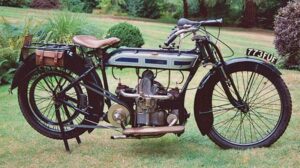 2-3/4 H.P. Models T. U, V, W, X. – Models T. U, V, W, X. in similar configuration to the 1912 Models G, H, J and K in terms of differences between the models. All switched to American Dixie magnetos when supplies of Bosh interrupted by hostilities. Last year single-speed offered. Model X. (Ladies Model) Exhaust pipes enter silencer under engine tangentially, for a spiral flow effect.
2-3/4 H.P. Models T. U, V, W, X. – Models T. U, V, W, X. in similar configuration to the 1912 Models G, H, J and K in terms of differences between the models. All switched to American Dixie magnetos when supplies of Bosh interrupted by hostilities. Last year single-speed offered. Model X. (Ladies Model) Exhaust pipes enter silencer under engine tangentially, for a spiral flow effect.
3-1/2 & 4 H.P. (500cc/600cc) SV Models A, B. – Used for wartime service and for sidecar work – look for distinguishing paint (Khaki!) or for signs of having pulled a chair – clamp/bolt marks, or even a bent frame! Cataloged as Model A and B (not to be confused with 2-3/4hp of 1907-08.) Physically larger engine, 68 x 68mm, horizontally divided crankcase. Sitting on a large base the fore part recognizable as an oil sump. Consequently no oil compartment in the petrol tank. Chain to 2-speed countershaft unit behind engine with cone clutch, thence belt to rear wheel. Model A, foot rests, no clutch. Model B, foot boards, clutch and kick start. Bifurcated twin front down tube frame, these tubes have ‘D’ shaped cross-section (conventional round tubes on later models.) Braced headstock. Rear brake block works on outside of belt rim (into V-groove.)
1915
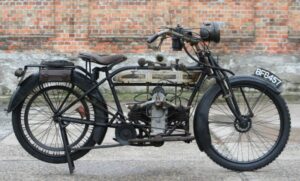 2-3/4 H.P. Models T. U, V, W, X. WD, – remained as models for 1915. Minor differences were that the rear stand pivots at a brazed-on dedicated lug, rather than a hole through the rear fork tube and a 3-speed gearbox available on some models. Cork plate clutch vs. cone, where fitted. Model WD (War Department), large mud shield at front of frame, no clutch. Last year for Ladies model.(The pictured machine was sold by Motomaniastore.com)
2-3/4 H.P. Models T. U, V, W, X. WD, – remained as models for 1915. Minor differences were that the rear stand pivots at a brazed-on dedicated lug, rather than a hole through the rear fork tube and a 3-speed gearbox available on some models. Cork plate clutch vs. cone, where fitted. Model WD (War Department), large mud shield at front of frame, no clutch. Last year for Ladies model.(The pictured machine was sold by Motomaniastore.com)
3-1/2 & 4 H.P. (500cc/600cc) SV Models A, B. – Larger 4hp model introduced, 74 x 68mm. Bosch magnetos unavailable due to war, Dixie magnetos were supplied, followed by CAV.
1916
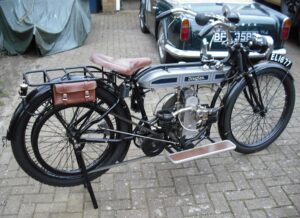 2-3/4 H.P. Models U, V, W, X. WD. WS. – Model U (foot boards) and Model V (foot pegs) both with either 2 or 3-speed. Model W, 3-speed and clutch. Model X still ladies model now with 3-speed and clutch. All models, new front fork, shackles are now inboard of girders, which has the leading tube straight and the trailing tube curved. Valve guides are now removable from cylinder. Addition of Model WS, specs as W with swing arm rear fork, suspension by cantilevered leaf springs. Not believed to have gone into production. Wartime production for civilian use much reduced.
2-3/4 H.P. Models U, V, W, X. WD. WS. – Model U (foot boards) and Model V (foot pegs) both with either 2 or 3-speed. Model W, 3-speed and clutch. Model X still ladies model now with 3-speed and clutch. All models, new front fork, shackles are now inboard of girders, which has the leading tube straight and the trailing tube curved. Valve guides are now removable from cylinder. Addition of Model WS, specs as W with swing arm rear fork, suspension by cantilevered leaf springs. Not believed to have gone into production. Wartime production for civilian use much reduced.
4 H.P. (500cc/600cc) SV – Models A, B. 3-1/2hp discontinued and A & B designations taken over by 4hp. Model A with 3-speed and clutch. Model B with same specs. Possibly there is a typo in the catalog and the A was still 2-speed. Archimedean screw oil pump replaced by rotary vane pump with auxiliary drip sight on petrol tank (all oil is still carried in the sump.) Offered also with sidecar. All welded front fork blade of lighter design similar to 2-3/4hp of same year, replacing a welded-brazed lug fork used previously. Primarily EIC magnetos used from this point on. Rear brake block now operates on inside of belt rim.
1917
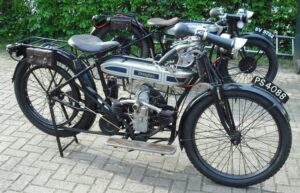 2-3/4 H.P. production ceased February for duration of the war. Presumably the Model WD continued.
2-3/4 H.P. production ceased February for duration of the war. Presumably the Model WD continued.
4 H.P. (500cc/600cc) SV Models A, B. – little known.
1918
2-3/4 H.P. Models U, V, W. – Military Models U,V,W with 2 or 3 speed gearboxes, optional clutch on 3-speed box. Many in khaki finish.
4 H.P. (500cc/600cc) SV Models A, B. – As a result of the utilisation of engines for other purposes, stationary generators, etc. the numbering system is not very rational. Gearboxes are stamped: G4/****(3-speed).
1919
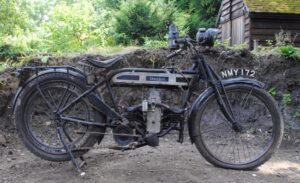 2-3/4 H.P. Models U, V, W. – Models U,V,W (see 1914 for differences between each model) British-made EIC magneto. No diagonal tube bracing headstock to top frame member. (Surplus braced headstock frames used into early twenties.) 1919 catalog literature suggests only a 3-speed was to be offered, but this must have changed and also there were many reconditioned ex-military 2-speeds sold by the factory. Mid-year an improved cork plate clutch of six plates, compressed by pressure plate and three toggle arms. Gearboxes now stamped with G2 / G3 for 2 /3 speed respectively. (The pictured one was sold through Bonhams)
2-3/4 H.P. Models U, V, W. – Models U,V,W (see 1914 for differences between each model) British-made EIC magneto. No diagonal tube bracing headstock to top frame member. (Surplus braced headstock frames used into early twenties.) 1919 catalog literature suggests only a 3-speed was to be offered, but this must have changed and also there were many reconditioned ex-military 2-speeds sold by the factory. Mid-year an improved cork plate clutch of six plates, compressed by pressure plate and three toggle arms. Gearboxes now stamped with G2 / G3 for 2 /3 speed respectively. (The pictured one was sold through Bonhams)
4 H.P. (500cc/600cc) SV Models A, B. – Headstock no longer braced. Gearboxes now stamped with G2 / G3 for 2 /3 speed respectively.
1920
2-3/4 H.P. Models WD, W20. Engine 60.8x60mm, 348cc. – Stronger welded lug front forks, Ferrodo clutch lining. (Surplus ‘veteran’ forks used into early twenties to deplete old stock.). Gearboxes now stamped: G2(2-speed), G3(3-speed), G6(W20),G8(W20, 3-speed w/clutch)
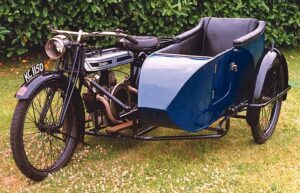 4 H.P. (500cc/600cc) SV Model B20. – Introduction of dry multi-plate clutch on gearbox. Gearboxes now stamped: G4/, G7/ (multi-plate).
4 H.P. (500cc/600cc) SV Model B20. – Introduction of dry multi-plate clutch on gearbox. Gearboxes now stamped: G4/, G7/ (multi-plate).
1921
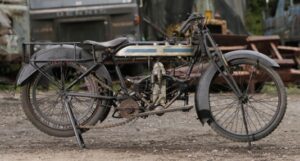 2-3/4 H.P. Models WD and W21. – Cork clutch reduced to four plates. Gearboxes now stamped: LG(WD),CG(W21), HG, IG, KG,
2-3/4 H.P. Models WD and W21. – Cork clutch reduced to four plates. Gearboxes now stamped: LG(WD),CG(W21), HG, IG, KG,
4 H.P. (500cc/600cc) SV Model B21. – Gearboxes now stamped: G4/, G7/ (multi-plate), G11/
3-1/2 H.P. OHV Sport, S1. 500cc – Gearbox mounted below rear cylinder. Single carburettor high and horizontal with down-swept intake manifold. 68mmx 68mm for 494cc. Kick start lever right-hand side of gearbox.
1922
2-3/4 H.P. Models WD and W21. – As 1921 but with 2-speed or 3-speed with clutch.
4 H.P. (500cc/600cc) SV Model B21. – Detachable cylinder heads with valve ports integral. Telescopic filler neck for oil sump. All lug brazed front fork. All chain drive version offered with sidecar outfit. Gearboxes stamped: G4/, G7/ (multi-plate), G11/
3-1/2 H.P. OHV Sport, S1. 500cc – Single carburettor still high and horizontal but intake manifold now level, circa 1922-23.
1923
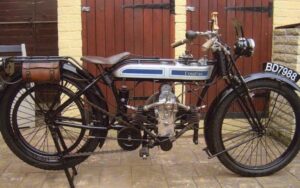 2-3/4 H.P. Models TS, W, 3SC. – Model TS, 2-speed. Model W, 3-speed with clutch and kick start, Model 3SC, 3-speed all chain drive, fitted with small diameter inverted v-wedge brakes from OHV model. Cooling fins on inlet ports.
2-3/4 H.P. Models TS, W, 3SC. – Model TS, 2-speed. Model W, 3-speed with clutch and kick start, Model 3SC, 3-speed all chain drive, fitted with small diameter inverted v-wedge brakes from OHV model. Cooling fins on inlet ports.
4 H.P. (500cc/600cc) SV Model B and 4HC. – Heated muff on intake manifold. Model B, solo, still belt drive. Model 4HC (sidecar), all chain drive. Model discontinued in favour of big OHV twins with sidecar the following year. Gearboxes stamped: G4/, G7/ (multi-plate), G11/.
3-1/2 H.P. OHV Sport, S1. 500cc – Superceded by RA (racing) and OB (sporting, sidecar.)
6 H.P. OHV Sport, S1, HE, 4HE 733cc – As S1 except engine well over square at 83mm x 68mm for 733cc! No known survivors in motorcycles, but variants of engine were used in powered gliders. Only have info showing S2 (solo) offered in 1923. Offered as sidecar combination H.E. (1923) and 4HE (1924).
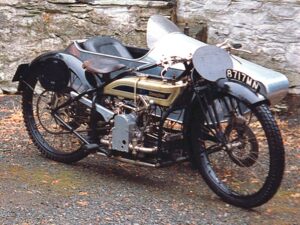 RA 500 / 600cc OHV – Gearbox mounted above rear cylinder, but attached to engine not frame. 68mm x 68mm. Twin carburettors breathing from a central air box. Hand change and gate mounted off top of air box. Under-slung cast alloy oil sump. No kick start lever. In 1923 the front lower frame lugs are blind.
RA 500 / 600cc OHV – Gearbox mounted above rear cylinder, but attached to engine not frame. 68mm x 68mm. Twin carburettors breathing from a central air box. Hand change and gate mounted off top of air box. Under-slung cast alloy oil sump. No kick start lever. In 1923 the front lower frame lugs are blind.
RW 350cc OHV – Identical to RA above, except 57mm x 68mm. Two surviving engines known, IE/1B**.
1924
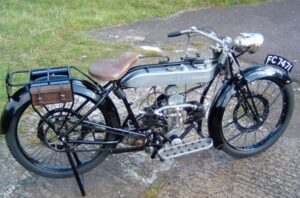 2-3/4 H.P. Models TS, SW, CW. – Model TS as in 1923. Model SW, 2-speed with flywheel clutch. Model CW, 3-speed all chain drive with flywheel clutch, dummy belt rim brakes (about half rim diameter) front and rear. CW frame numbering starts at 101, but engine numbers continue in series with TS and SW. Gearboxes are now stamped: LG(TS), NG(2-speed), OG(3-speed).
2-3/4 H.P. Models TS, SW, CW. – Model TS as in 1923. Model SW, 2-speed with flywheel clutch. Model CW, 3-speed all chain drive with flywheel clutch, dummy belt rim brakes (about half rim diameter) front and rear. CW frame numbering starts at 101, but engine numbers continue in series with TS and SW. Gearboxes are now stamped: LG(TS), NG(2-speed), OG(3-speed).
6 H.P. OHV Sport, S1, HE, 4HE 733cc -As S1 except engine well over square at 83mm x 68mm for 733cc! No known survivors in motorcycles, but variants of engine were used in powered gliders. Only have info showing S2 (solo) offered in 1923. Offered as sidecar combination H.E. (1923) and 4HE (1924).
RA 500 / 600cc OHV – Gearbox mounted above rear cylinder, but attached to engine not frame. 68mm x 68mm. Twin carburettors breathing from a central air box. Hand change and gate mounted off top of air box. Under-slung cast alloy oil sump. No kick start lever. The front lower lug is now open to allow a through bolt for sidecar mounting, but rear remains blind.
RW 350cc OHV – Identical to RA above, except 57mm x 68mm. Two surviving engines known, IE/1B**
TW 350cc OHV – Third horizontal chain-stay struts. Otherwise probably the same as the RW. Listed as the TW/24 for Australia, 2-3/4hp. One survivor known.
OW 350cc OHV – 57mm x 68mm. Kick start lever on timing chest. First model where the petrol tank slopes from headstock to saddle. Single updraft carburettor with down-swept intake manifold to each cylinder. Dummy belt rim brakes. Hand shift along side petrol tank.
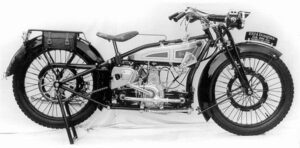 OB 600cc OHV – Similar to OW, but 68mm x 82mm. Early catalogue pictures shown RA/RW style mounted gearbox, but it is believed all production had gearbox mounted to frame under the saddle. Single updraft carburettor with down-swept intake manifold. Dummy belt rim brakes. Manifold eventually fully jacketed by aluminium casting.
OB 600cc OHV – Similar to OW, but 68mm x 82mm. Early catalogue pictures shown RA/RW style mounted gearbox, but it is believed all production had gearbox mounted to frame under the saddle. Single updraft carburettor with down-swept intake manifold. Dummy belt rim brakes. Manifold eventually fully jacketed by aluminium casting.
1925
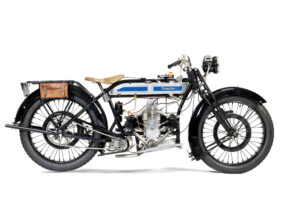 2-3/4 H.P. Model TS25, CW25 – same as Models TS and CW in 1924. Gearboxes now stamped LG(TS), OG(CW).
2-3/4 H.P. Model TS25, CW25 – same as Models TS and CW in 1924. Gearboxes now stamped LG(TS), OG(CW).
RA 500 / 600cc OHV – Lower front and rear frame lugs are open for through bolts (like the OB model). One source assigns JF to 1925 frames. But extant frames use a DF prefix. Ditto engines, which were assigned WE (500cc) and VE (600cc), yet only FE and GE have been seen. 600cc version not catalogued in 1925, but available to order. RAs were definitely produced into 1926 (and perhaps later for the dirt track market) though not cataloged after 1925.
RW 350cc OHV – Catalogued but none seen. See spec in 1923/4.
OW 350cc OHV – Gearbox above rear cylinder, but now attached to frame under saddle, not engine (possibly started in 1924.) Main-shaft at rear of gearbox.
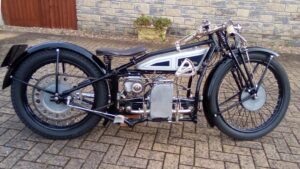 OB 600cc OHV – Catalogued with manifold above, but switched to level intake manifold with horizontal carburettor mounted above.
OB 600cc OHV – Catalogued with manifold above, but switched to level intake manifold with horizontal carburettor mounted above.
I.o.M Model 350cc OHV – Works team only for Isle of Man TT.
TT Replica Model, I.o.M Model 500/600cc OHV – Works team only for Isle of Man TT.
1926
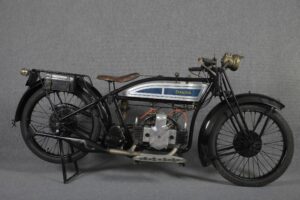 2-3/4 H.P. Models TS26, CW26, EW. – Model TS26 same as 1924 TS. Model CW26 with shock absorber in gearbox sprocket. CW just reaches frame numbers of five digits. Last year for venerable 2-3/4hp, though a timing cover engraved for 1927 has been seen. Last year for belt drive, clutch-less, 2-speed with stirrup front brake (the TS)! Discontinued when stocks exhausted in favour of new 350cc Model EW, introduced late 1925 (see 1927). Gearboxes were stamped: LG(TS), A/OG(CW).
2-3/4 H.P. Models TS26, CW26, EW. – Model TS26 same as 1924 TS. Model CW26 with shock absorber in gearbox sprocket. CW just reaches frame numbers of five digits. Last year for venerable 2-3/4hp, though a timing cover engraved for 1927 has been seen. Last year for belt drive, clutch-less, 2-speed with stirrup front brake (the TS)! Discontinued when stocks exhausted in favour of new 350cc Model EW, introduced late 1925 (see 1927). Gearboxes were stamped: LG(TS), A/OG(CW).
I.o.M Model 350cc OHV – 350cc was catalogued but bore and stroke not known. Otherwise same as 500/600cc I.o.M Model. Possibly available with VG & SG prefix gearboxes.
TT Replica Model, I.o.M Model 500/600cc OHV – Twin carburettor with air box, gently sloping tank top, still has threaded intake and exhaust port gland nuts. Gearbox above rear cylinder mounted to frame under saddle. No kick start provision on I.o.M Models. Available to factory riders in 1925, with the Douglas servo band drum brakes. Main-shaft at front of gearbox. Available to order 750cc. Early frames (probably 1925 Works machines) have rear axle lugs like RA, later replaced by brazed lugs used subsequently on DT.
Model OC 600cc SV – This 600cc Douglas replaced OB model. Douglas servo band drum brakes. Unlike OB, the main-shaft is now at front of gearbox. With footboards or footrests. Hand shift passes through petrol tank. Early models (late 1925) could be fitted with QG*** gearbox.
Model EW 350cc SV – Launched in 1925 but numbers shown from 1926-on. 60.8mm x 60mm. Gear change lever through slot in petrol tank; gearbox behind engine. First SV with gently sloping tank top. Gearbox mounts on four studs. With or without electric lighting. Sports version with foot pegs and aluminium pistons. Deluxe version also available.
1927
I.o.M Model 350cc OHV – Shared frame with 500/600cc I.o.M Model.
TT Replica Model, I.o.M Model 500/600cc OHV – Likely no significant change.
Model OC 600cc SV – Spec as in 1926
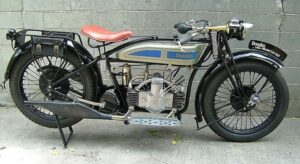 Model EW 350cc SV – As in 1926 but with gearbox clamps around frame tubes.
Model EW 350cc SV – As in 1926 but with gearbox clamps around frame tubes.
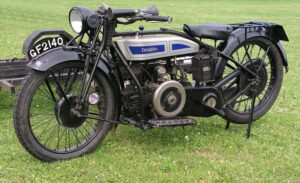 Model EW 600 (SB27) Sport SV – 68mm x 82mm. S/* denotes sports model with aluminium pistons, drop handlebars and foot pegs instead of touring handlebars, cast iron pistons, and foot boards. With or without electric lighting. Oil sight glass built into face of timing chest cover, not on top of petrol tank like the 350cc EW. Leather pan saddle. Sometimes called the SB27, catalogued as EW 600. Full duplex front down tubes. Detachable cylinder heads incorporating valve ports.
Model EW 600 (SB27) Sport SV – 68mm x 82mm. S/* denotes sports model with aluminium pistons, drop handlebars and foot pegs instead of touring handlebars, cast iron pistons, and foot boards. With or without electric lighting. Oil sight glass built into face of timing chest cover, not on top of petrol tank like the 350cc EW. Leather pan saddle. Sometimes called the SB27, catalogued as EW 600. Full duplex front down tubes. Detachable cylinder heads incorporating valve ports.
1928
I.o.M Model 350cc OHV – Shared frame with 500/600cc I.o.M Model.
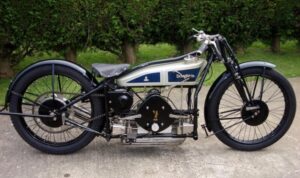 TT Replica Model, I.o.M Model 500/600cc OHV – Likely no significant change.
TT Replica Model, I.o.M Model 500/600cc OHV – Likely no significant change.
Model EW (A28, B28, C28) 350cc SV – The EW now had variants to the umbrella model name. The A28 had foot pegs as standard. A cloth saddle replaces leather pan. There was a version called the B28 with detachable cylinder heads (incorporating valve ports), and the C28 with same heads but aluminium pistons.
Model EW (F28) 600 Sport SV – Steering friction damper under handlebars. Cloth covered sprung saddle. Catalogued as the F28.
Model B28 350cc SV – Colonial version of the A28, not built to 224lb. weight limit.
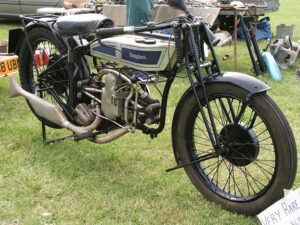 Model D28 350cc OHV – OHV built on the crankcase of the 350 SV EW. Enclosed pushrods on side of engine (rather than on top like the other OHV models.) Spark plugs on the left. Gearbox below rear cylinder. Flat tank. Hand shift lever mounted down alongside front cylinder.
Model D28 350cc OHV – OHV built on the crankcase of the 350 SV EW. Enclosed pushrods on side of engine (rather than on top like the other OHV models.) Spark plugs on the left. Gearbox below rear cylinder. Flat tank. Hand shift lever mounted down alongside front cylinder.
Model G28 / H28 500 / 600cc OHV – Continuation of Douglas OC model (see 1927), unchanged. G28 was 500cc and H28 600cc. Probably continued to used same prefix codes as OC.
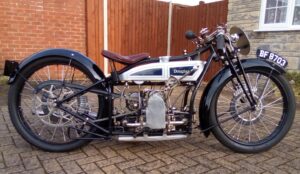 Model RA28 (Dirt Track) 500cc OHV – This was an interim model, predating the release of the Dirt Track model in June 1928. Frame was DT model, yet it had the lugs (unused) for the RA braking system. Engine was left-over RA units (one example of a frame and engine are known), but it is not known what style gearbox. Provision for mounting to the frame or the engine are present! Probably the gearbox was mounted to the frame (a.k.a. DT) since these gearboxes were available since 1924 (OB model), and there was no provision to brace the gearbox to the frame, as required by the RA model gearbox. No period image known, one surviving frame and engine known.
Model RA28 (Dirt Track) 500cc OHV – This was an interim model, predating the release of the Dirt Track model in June 1928. Frame was DT model, yet it had the lugs (unused) for the RA braking system. Engine was left-over RA units (one example of a frame and engine are known), but it is not known what style gearbox. Provision for mounting to the frame or the engine are present! Probably the gearbox was mounted to the frame (a.k.a. DT) since these gearboxes were available since 1924 (OB model), and there was no provision to brace the gearbox to the frame, as required by the RA model gearbox. No period image known, one surviving frame and engine known.
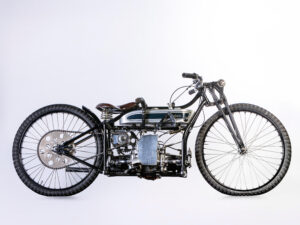 Model DT5 / DT6 (Dirt Track), SW5 / SW6 (Speedway) 500 / 600cc OHV – Gearbox above rear cylinder mounted to frame under saddle. Tall air box, twin Amac carburettors. Oil held in front compartment of petrol tank, hand pump manual oiling only. 62.25mm x 82mm (500cc) and 68mm x 82mm (600cc). Single central spring on front fork. Early frames can have brake and saddle lugs from RA model (though brakes not used of course.)
Model DT5 / DT6 (Dirt Track), SW5 / SW6 (Speedway) 500 / 600cc OHV – Gearbox above rear cylinder mounted to frame under saddle. Tall air box, twin Amac carburettors. Oil held in front compartment of petrol tank, hand pump manual oiling only. 62.25mm x 82mm (500cc) and 68mm x 82mm (600cc). Single central spring on front fork. Early frames can have brake and saddle lugs from RA model (though brakes not used of course.)
1929
I.o.M Model 350cc OHV – Shared frame with 500/600cc I.o.M Model.
TT Replica Model, I.o.M Model 500/600cc OHV – Likely no significant change.
Model EW (A29) 350cc SV – One model variant only called A29. Continues with flat tank to use up stock while other 1929 models get a saddle tank.
Model EW (E29, F29) 600 Sport SV – Saddle tank, necessitating a change to the upper part of the frame. E29 had foot boards, F29 had foot pegs and drop handlebars (continuation of Sport model.) Oil sight glass (same unit as mounted on petrol tank of EW) attached to small corbel on face of timing cover.
Model B29, L29 350cc SV – Douglas B29 with saddle tank. Engine now sits on large cast aluminium oil sump, no oil sight glass. L29 was a war department model.
Model D28 350cc OHV – The only apparent variation to the 1928 production models was the saddle tank finished with celluloid.
Model G29 / H29 500 / 600cc OHV – Spec as in 1928 and just the model name changes. Now called G29 and H29 respectively.
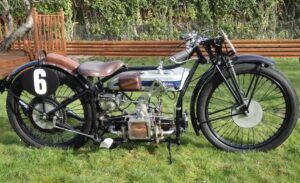 Model DT5 / DT6 (Dirt Track), SW5 / SW6 (Speedway) 500 / 600cc OHV – Specification as in 1928. Altered for 1930-32.
Model DT5 / DT6 (Dirt Track), SW5 / SW6 (Speedway) 500 / 600cc OHV – Specification as in 1928. Altered for 1930-32.
1930
Model B29, L29 350cc SV – Catalogued but no engine or frame numbers given but see H3, L3, B31 and B32 models.
Model DT5 / DT6 (Dirt Track), SW5 / SW6 (Speedway) 500 / 600cc OHV – Small, square air box with mechanical oil pump, oil drip sight glass mounted on top of air box; road versions had brakes and flywheel clutch. Amal track carburettors. Still has hand pump for auxiliary oiling.
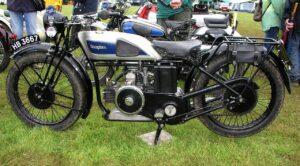 Model H3, L3 350cc OHV – Continuation of B29. 1930 models with foot boards and celluloid finished petrol tank called the L3 and foot pegs. Deeper mudguards, chromium plated petrol tank and larger flywheel the H3. Low reduction gearbox option on L3/H3. Centre stand replaces rear stand. Hand shift lever passes through gate attached to side of petrol tank.
Model H3, L3 350cc OHV – Continuation of B29. 1930 models with foot boards and celluloid finished petrol tank called the L3 and foot pegs. Deeper mudguards, chromium plated petrol tank and larger flywheel the H3. Low reduction gearbox option on L3/H3. Centre stand replaces rear stand. Hand shift lever passes through gate attached to side of petrol tank.
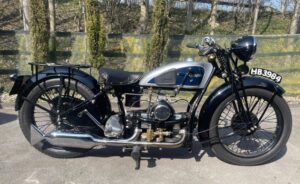 Model S5, S6, T6 500/600/cc SV – Gearbox numbers and codes variable, frame numbers up to around 3200. Most Register machines are 1930/31. Detachable plate style cylinder heads, inlet manifold cast integral with timing cover, ports on side of cylinders. All 82mm stroke with 62.25, 68, and 76mm bore. Centre stand. T6 had celluloid finish tank and foot boards, others were chromium plated tank and had foot rests. S5 was 500cc, S6 a 600cc. Single central front compression fork spring, lower links inside girder blades.
Model S5, S6, T6 500/600/cc SV – Gearbox numbers and codes variable, frame numbers up to around 3200. Most Register machines are 1930/31. Detachable plate style cylinder heads, inlet manifold cast integral with timing cover, ports on side of cylinders. All 82mm stroke with 62.25, 68, and 76mm bore. Centre stand. T6 had celluloid finish tank and foot boards, others were chromium plated tank and had foot rests. S5 was 500cc, S6 a 600cc. Single central front compression fork spring, lower links inside girder blades.
1931
Model DT5 / DT6 (Dirt Track), SW5 / SW6 (Speedway) 500 / 600cc OHV – Same specification as 1930. Eccept, see below for the short stroke version.
Model B31 350cc OHV – B31 replaces both L3 & H3. Chromium plated petrol tank with tartan panels. Twist grip throttle standard, lever throttle optional.
Model C31, E31, T6 500/600cc SV – Specification as in 1930 S5 / S6 except 500cc now C31 model, 600cc E31 model with choice of foot boards or foot rests. All petrol tanks chromium plated with tartan panels.
Model DT5 500cc OHV – Short-stoke version of DT, 68mm x 68mm, shorter wheelbase. Reinforced drive-side gearbox shell. One frame known stamped with TF prefix of long wheelbase DT. In theory, it should have been assigned a new prefix as the frame is different. Gearbox platform does not drop down like DT, but comes straight forward from cross tube; similar, but not the same casting as F/G31 models.
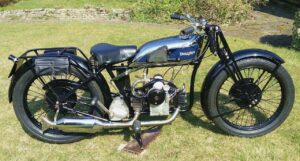 Model A31 350cc SV – Chromium plated petrol tank with tartan panel, hand shift lever passes through knee grip which acts as gate. Oil sight glass mounted on timing chest cover.
Model A31 350cc SV – Chromium plated petrol tank with tartan panel, hand shift lever passes through knee grip which acts as gate. Oil sight glass mounted on timing chest cover.
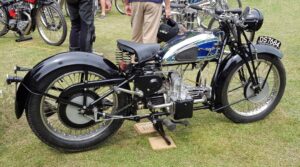 Model F31 / G31 500 / 600cc OHV – 62.25mm (500cc) and 68mm (600cc) bore both with 82mm stroke. Frame numbers up to about 200, few made. Redesigned version of G28/F28 after one year absence. Saddle tank, chromium plate with tartan panels. Fully enclosed valve gear. Single carburetor inside airbox, flanged manifolds. Single compression spring front fork (same as DT/SW.) Centre stand. Kick start lever now on gearbox. Catalogued as F32 & G32 in 1932, F33 & G33 in 1933 (1932 leftovers.)
Model F31 / G31 500 / 600cc OHV – 62.25mm (500cc) and 68mm (600cc) bore both with 82mm stroke. Frame numbers up to about 200, few made. Redesigned version of G28/F28 after one year absence. Saddle tank, chromium plate with tartan panels. Fully enclosed valve gear. Single carburetor inside airbox, flanged manifolds. Single compression spring front fork (same as DT/SW.) Centre stand. Kick start lever now on gearbox. Catalogued as F32 & G32 in 1932, F33 & G33 in 1933 (1932 leftovers.)
1932
Model DT5 / DT6 (Dirt Track), SW5 / SW6 (Speedway) 500 / 600cc OHV – Same specification as 1930/1. EL1296 dispatched July 1932.
Model B32 350cc OHV – Elimination of sump, oil carried in petrol tank compartment. Redesigned cylinders and aluminium plate style cylinder heads. Flanged manifolds instead of gland nuts. Hand shift lever passes through knee grip which acts as gate. Engine code assigned to enclosed flywheel design that may not have been marketed, no examples known. May have continued with EN prefix. Ditto frame code FH, may have used a FC prefix frame as per model A31, as catalogue illustrations show them to be similar.
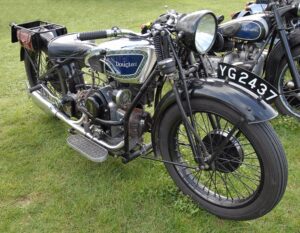 Model D32 (Greyhound), E32 (Ayredale) 600, H32 (Mastiff) 750cc SV – See Models S5 / S6 / T6 in 1930 for basic specification. No 500cc version. 600cc Sports now D32 or Greyhound and 600cc touring is E32 or Ayredale. Added 750cc touring model H32 or Mastiff. Ayredale & Mastiff continue to use old heavyweight duplex spring forks, though girders are slightly longer to suit larger section balloon tyres.
Model D32 (Greyhound), E32 (Ayredale) 600, H32 (Mastiff) 750cc SV – See Models S5 / S6 / T6 in 1930 for basic specification. No 500cc version. 600cc Sports now D32 or Greyhound and 600cc touring is E32 or Ayredale. Added 750cc touring model H32 or Mastiff. Ayredale & Mastiff continue to use old heavyweight duplex spring forks, though girders are slightly longer to suit larger section balloon tyres.
Model A32 (Terrier) 350cc SV – See 1931 model A31 for basic specification. Now called A32 or Terrier, possibly available with B32 plate style heads (not seen) when old style stock used up.
Model F32 / G32 500 / 600cc OHV – First launched in 1931 at F31 / G31. 62.25mm (500cc) and 68mm (600cc) bore both with 82mm stroke. Frame numbers up to about 200, few made. Redesigned version of G28/F28 after one year absence. Saddle tank, chromium plate with tartan panels. Fully enclosed valve gear. Single carburettor inside air box, flanged manifolds. Single compression spring front fork (same as DT/SW.) Centre stand. Kick start lever now on gearbox. Catalogued as F32 & G32 in 1932, F33 & G33 in 1933 (1932 leftovers.)
Model C32 (Bulldog) 500cc SV – Lightweight 500cc based on B32. Detachable aluminium plate style heads. Replaced 500cc C31 that was based on heavy-weight models (S5 derivative.)
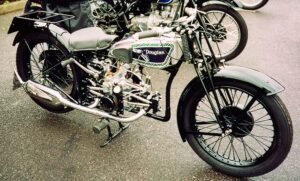 Model K32 / M32 350 / 500cc OHV – Redesign of discontinued D29. Gearbox now mounted under saddle. Centre stand. Chromium plated saddle tank with tartan panels. Pushrods on the side of engine as it is based on the SV crankcase. Spark plugs now on right.
Model K32 / M32 350 / 500cc OHV – Redesign of discontinued D29. Gearbox now mounted under saddle. Centre stand. Chromium plated saddle tank with tartan panels. Pushrods on the side of engine as it is based on the SV crankcase. Spark plugs now on right.
1933
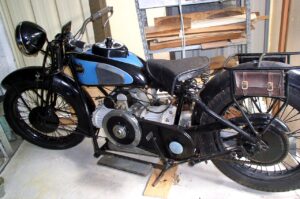 Model D33 / E33 600cc. H33 750cc SV – Factory production nil due to acute financial distress. Finned intake manifold, down-draught carb, dyno over front cylinder. Instrument panel sits atop petrol tank, metal tank badges. 600cc continues as D33/E33 (Two examples known), 750cc as H33.
Model D33 / E33 600cc. H33 750cc SV – Factory production nil due to acute financial distress. Finned intake manifold, down-draught carb, dyno over front cylinder. Instrument panel sits atop petrol tank, metal tank badges. 600cc continues as D33/E33 (Two examples known), 750cc as H33.
Model F33 / G33 500 / 600cc OHV – First launched in 1931 at F31 / G31. 62.25mm (500cc) and 68mm (600cc) bore both with 82mm stroke. Frame numbers up to about 200, few made. Redesigned version of G28/F28 after one year absence. Saddle tank, chromium plate with tartan panels. Fully enclosed valve gear. Single carburettor inside air box, flanged manifolds. Single compression spring front fork (same as DT/SW.) Centre stand. Kick start lever now on gearbox. Catalogued as F32 & G32 in 1932, F33 & G33 in 1933 (1932 leftovers.)
Model X 150cc 2-Stroke – Horizontal Villiers single cylinder two-stroke engine, radial fins on cylinder. Tubular struts above engine. Sheet metal enclosure of the engine bay. With flywheel magneto lighting or with Lucas dynamo lighting.
1934
Model X/ X1 (Bantam) 150cc 2-Stroke – Douglas built copy of Villiers engine (used in 1933), axial fins on cylinder. Pressed channel sheet metal strut above engine. Catalogued Bantam as well as X with flywheel lighting and X1 with dynamo lighting. 1935 catalogued 5X and 5X1.
Model Y 250cc SV – 51mm x 60mm. Redesigned cylinders with iron detachable plate style heads. Intake and exhaust manifolds now flanged instead of gland nuts. Chromium plated petrol tank with blue panels. Lightweight forks as per A32, or pressed sheet metal per Bantam. Rear carrier with leather toolboxes. Catalogued as Model Y.
Model Y1 350cc SV – Continuation of the A32, but with chromium plated petrol tank with blue panels. Rear carrier with leather toolboxes. Catalogued as Y1. Probably continued with same prefix codes for frame and gearbox.
Model Y2 500cc SV – Continuation of the C32, but with iron heads. Probably continued with same prefix codes for frame and gearbox. 70 x 60mm Otherwise similar to Cotswold and Comet.
Model Z 600cc SV – Redesigned cylinders and heads on the D33/E33 crankcase, external geared oil pump. New single front down tube frame, trans mounts of continuation of engine rails. No sump, oil in petrol tank compartment. Saddle tank has more bulbous shape, with inset instrument panel, chromium plate with blue panels. Four speed gearbox in hand and foot shift versions. New heavy-weight lugged forks with lower links to outside and large central barrel shape spring. Catalogued as Z.
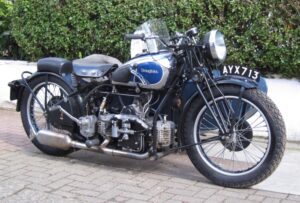 Model Z1 750cc SV – Redesigned cylinders and heads on the D33/E33 crankcase, external geared oil pump. New duplex front down tube frame, trans mounts of continuation of engine rails. No sump, so oil in petrol tank compartment. Saddle tank has more bulbous shape, with inset instrument panel. Four speed gearbox in hand and foot shift versions. New heavy-weight lugged forks with lower links to outside and large central barrel shape spring. Catalogued as Z1.
Model Z1 750cc SV – Redesigned cylinders and heads on the D33/E33 crankcase, external geared oil pump. New duplex front down tube frame, trans mounts of continuation of engine rails. No sump, so oil in petrol tank compartment. Saddle tank has more bulbous shape, with inset instrument panel. Four speed gearbox in hand and foot shift versions. New heavy-weight lugged forks with lower links to outside and large central barrel shape spring. Catalogued as Z1.
Model OW/ OW1 500 / 600 cc OHV – Redesign of F/G models of 1932. Same cylinders, heads, and valve enclosure on new crankcase. No air box. Single updraft Douglas barrel carburettor. Full duplex frame. Saddle tank has more bulbous shape, with inset instrument panel, chromium plate with blue panels. Four speed gearbox in hand and foot shift versions. Uses new heavy-weight front fork per Wessex/Powerflow. Catalogued as OW (500cc) or OW1 (600cc). Total production about thirty 1934-35.
1935
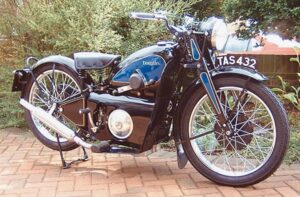 Model 5X/ 5X1 (Bantam) 150cc 2-Stroke – Douglas built copy of Villiers engine (used in 1933), axial fins on cylinder. Pressed channel sheet metal strut above engine. Catalogued Bantam as well as X with flywheel lighting and X1 with dynamo lighting. 1935 catalogued 5X and 5X1.
Model 5X/ 5X1 (Bantam) 150cc 2-Stroke – Douglas built copy of Villiers engine (used in 1933), axial fins on cylinder. Pressed channel sheet metal strut above engine. Catalogued Bantam as well as X with flywheel lighting and X1 with dynamo lighting. 1935 catalogued 5X and 5X1.
Model 5Y (Comet) 250cc SV – Saddle tank has more bulbous shape, black with blue panels. Welded girder forks, large central barrel shape spring, lower headstock lug larger for taper roller bearing. Single down tube frame divided into two tubes under engine. Hand shift gate on side of petrol tank instead of through knee grip. No rear carrier, cast aluminium toolbox on left. New cylinders and plate style heads. Catalogued as 5Y and Comet.
Model 5Y1 (Cotswold) 350cc SV – Redesigned cylinders and heads, basically identical to 1935 250cc with larger cylinder bore. Shared frame with 250cc. Catalogued as 5Y1 and Cotswold.
Model 5Z (Wessex) 600cc SV – See basic specification in Model Z for 1934. Variations for this year include; Petrol tank finish now black, with blue panels. Oddly, reverted to rear stand with centre stand optional. Catalogued as 5Z and Wessex. Brake backing plates painted black, in common with all 1935 models.
Model 5Z1 Powerflow 750cc SV – See 1935 Model Z1 for basic specification with alterations for 1935 as follows: Petrol tank finish now black, with blue panels. Oddly, reverted to rear stand with centre stand optional. Catalogued as 5Z1 and Powerflow.
Model OW/ OW1 Speed Special 500 / 600 cc OHV – See 1934 OW / OW1 for basic specification with alterations for 1935 to include: Petrol tank finish now black, with blue panels. Dual exhaust into cast alloy tubular silencers. The few remaining examples may well have been built in 1934, as they use ’34 engine prefixes. However the timing cover was new, as the air box returned. Douglas carburettor or updraft Amal (as used on S6). Rear portion of mudguard detachable. Catalogued additionally as Speed Special as well as OW/OW1. At least one 750cc was built, but not catalogued.
Model Blue Chief 500cc OHV – New design engine of 68mm x 68mm, alloy cylinders and heads. Saddle tank has more bulbous shape, with inset instrument panel, chromium plate with blue panels. Uses new light-weight welded front fork per Comet/Cotswold. Catalogued as four-speed, but three-speed depicted! Probably three-speed only on early models designed for War Office, with knock-out rear spindle option (frame prefix FV/***, no known survivors) and this was used as catalog illustration.
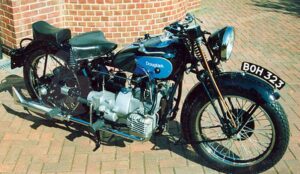 Model Endeavour 500cc SV – This is the only pre-war transverse twin Douglas Motorcycles model manufactured. They used Blue Chief (Y2) engine turned sideways with unit construction gearbox, shaft drive. Impossible to mistake for any other model. Total production about one hundred 1935-36. Pre-production units had oil fill for trans at top of housing, first production had oil fill at an angle on right hand side of trans, then finally oriented so fill cap was level.
Model Endeavour 500cc SV – This is the only pre-war transverse twin Douglas Motorcycles model manufactured. They used Blue Chief (Y2) engine turned sideways with unit construction gearbox, shaft drive. Impossible to mistake for any other model. Total production about one hundred 1935-36. Pre-production units had oil fill for trans at top of housing, first production had oil fill at an angle on right hand side of trans, then finally oriented so fill cap was level.
1936
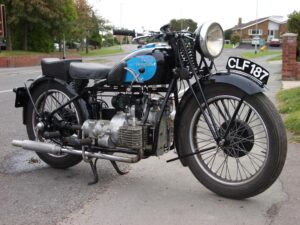 Model Endeavour 500cc SV – This is the only pre-war transverse twin Douglas Motorcycles model manufactured. They used Blue Chief (Y2) engine turned sideways with unit construction gearbox, shaft drive. Impossible to mistake for any other model. Total production about one hundred 1935-36. Pre-production units had oil fill for trans at top of housing, first production had oil fill at an angle on right hand side of trans, then finally oriented so fill cap was level.
Model Endeavour 500cc SV – This is the only pre-war transverse twin Douglas Motorcycles model manufactured. They used Blue Chief (Y2) engine turned sideways with unit construction gearbox, shaft drive. Impossible to mistake for any other model. Total production about one hundred 1935-36. Pre-production units had oil fill for trans at top of housing, first production had oil fill at an angle on right hand side of trans, then finally oriented so fill cap was level.
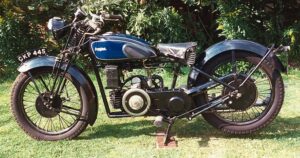 Model Aero 250cc SV – Probably S/ prefix code gearbox. Three-speed. Reverted back to small petrol tank of 1932 models, painted black with blue panels. Engine same as Cotswold/Comet of 1935.
Model Aero 250cc SV – Probably S/ prefix code gearbox. Three-speed. Reverted back to small petrol tank of 1932 models, painted black with blue panels. Engine same as Cotswold/Comet of 1935.
Model Aero 350cc SV – Same as 250cc except bore.
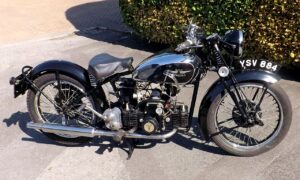 Model Aero 500 / 600cc SV – Continuation of the Blue Chief engine but with cast iron cylinders and heads. 74mm bore added for the 600cc. Instrument panel gone. Foot-shift option is discontinued. Uses light-weight front fork of 250/350cc Aero models.
Model Aero 500 / 600cc SV – Continuation of the Blue Chief engine but with cast iron cylinders and heads. 74mm bore added for the 600cc. Instrument panel gone. Foot-shift option is discontinued. Uses light-weight front fork of 250/350cc Aero models.
1937
Model Aero 350cc SV – Same as 250cc (in 1936) except bore.
 Model Aero 600cc SV – Aero Tank transfer this year only. Douglas started stamping engine and frame with same prefix code. 500cc dropped.
Model Aero 600cc SV – Aero Tank transfer this year only. Douglas started stamping engine and frame with same prefix code. 500cc dropped.
1938
Model Aero (DC/38) 600cc SV – Oval tank transfer. Catalogued as DC/38. Allegedly last models used Web girder forks when supply of Douglas forks ran out. Leftovers sold into 1939.
Model CL/38 150cc 2-Stroke – Single cylinder vertical 2-stroke engine, copy of Villiers. Two port exhaust. Debatable if it was ever put into production, one replica recently built.
1939
Any leftovers were sold in 1939.
Prewar Douglas Motorcycles – more information including how to date your Douglas.
- Dating your Douglas 2-3/4 H.P. model by engine or frame number. View the table here
- Dating your Douglas 3-1/2 HP or 4 HP by engine or frame number. View the table here
- BUY – If you are looking for prewar Douglas motorcycle spares, including parts for pioneers, veteran or vintage motorbikes, then please view PREWAR DOUGLAS MOTORCYCLE SPARES
- Spares Lists – Douglas motorcycles Spare parts lists and information.
- SELL – Looking to sell prewar Douglas motorcycles, spare parts, or project motorbikes? Please try this page
Credits: Thanks to various sources for the information. Much of the model specifications were compiled by “Doug K” and “Doug C” from The Douglas Forum. The information has been used with Doug K’s kind permission. Some of the images are of machines sold by Bonhams and a few are of club members’ motorcycles, from the DouglasMCC domain.
Disclaimer: The information supplied here is a guide. It’s a pretty accurate guide, but should be used as such.
If you have a prewar Douglas motorcycle, please join the London Douglas Motorcycle Club. It is available to everyone; owners and non-owners in any Country.
